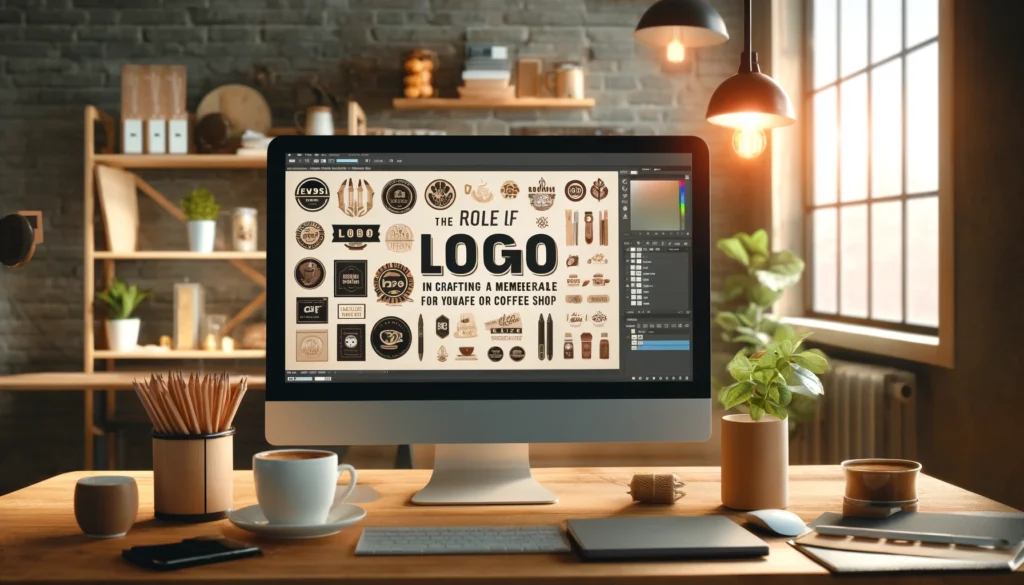







In the handmade and artisanal market, where products are often crafted with care and attention to detail, a strong logo can play a pivotal role in driving sales and building brand recognition. Your logo is more than just a visual mark; it’s a symbol of the quality, craftsmanship, and uniqueness that sets your products apart from mass-produced goods. A well-designed logo can help you stand out in a crowded marketplace, attract customers who value authenticity, and convey the story behind your brand. This article explores the importance of a unique logo for handmade craft businesses, showcases case studies of successful brands, and offers practical tips for creating a logo that resonates with your target audience.
The handmade and artisanal market is flourishing, with countless small businesses and independent artisans offering a wide range of products. In such a competitive environment, establishing a strong brand identity is crucial for standing out. Your logo serves as the cornerstone of this identity, providing a visual representation of your brand’s values, craftsmanship, and uniqueness.
A unique logo helps potential customers recognize and remember your brand, making it more likely that they will choose your products over those of competitors. It also sets the tone for your entire brand, conveying the quality and care that go into each handmade item. By investing in a well-crafted logo, you lay the foundation for a strong and recognizable brand that can thrive in the crowded handmade market.
One of the key selling points of handmade products is their uniqueness and the personal touch that goes into their creation. Unlike mass-produced goods, handmade items often carry a story—a narrative of craftsmanship, creativity, and passion. Your logo should reflect this narrative, differentiating your products from those that are mass-produced and often perceived as less authentic.
A logo that conveys the artisanal nature of your products can help attract customers who are looking for something special and unique. Whether through hand-drawn elements, organic shapes, or rustic typography, your logo should communicate that your products are made with care and attention to detail. This differentiation can be a powerful driver of sales, as it appeals to customers who value quality, authenticity, and individuality.
Trust is a critical factor in the handmade market, where customers often seek reassurance that the products they are purchasing are of high quality and genuinely handcrafted. A professional and well-designed logo can help build this trust by conveying a sense of reliability and credibility. When customers see your logo, they should feel confident that they are buying from a reputable brand that takes pride in its work.
Consistency in branding is also key to building trust. By using your logo consistently across all touchpoints—from your website and social media profiles to packaging and marketing materials—you create a cohesive brand image that reinforces your commitment to quality. Over time, this consistency helps establish your brand as a trusted and reliable source for handmade goods.
The design elements of your logo—such as shapes, lines, and layout—can effectively communicate the artisanal quality of your products. For instance, hand-drawn or textured elements can convey the handmade nature of your goods, while organic shapes and flowing lines can suggest creativity and craftsmanship. These design choices help create a visual language that resonates with customers who value the artistry and skill involved in creating handmade items.
Incorporating subtle details, such as a hand-drawn illustration or a vintage-inspired design, can further enhance the perception of your products as unique and carefully crafted. These elements help tell the story of your brand and the care that goes into each piece, making your logo a reflection of the values that set your handmade business apart.
Color and typography are powerful tools in logo design, especially when it comes to communicating authenticity and craftsmanship. Earthy tones like browns, greens, and muted shades can evoke a sense of natural, organic quality, making them ideal for brands that emphasize sustainability and handmade craftsmanship. Bright, bold colors, on the other hand, can convey energy, creativity, and a modern approach to artisanal goods.
Typography also plays a crucial role in shaping the perception of your brand. A serif font might suggest tradition and reliability, while a handwritten or script font could convey a personal touch and individuality. The key is to choose colors and fonts that align with your brand’s personality and the story you want to tell, ensuring that your logo communicates the authenticity and quality that customers expect from handmade products.
Incorporating a handmade aesthetic into your logo design can further reinforce the uniqueness and craftsmanship of your products. This can be achieved through the use of hand-drawn illustrations, textured effects, or organic, imperfect shapes that mimic the look of handmade goods. These elements help create a logo that feels personal, authentic, and reflective of the care and attention that goes into each of your products.
A handmade aesthetic in your logo not only sets your brand apart from mass-produced competitors but also creates an emotional connection with customers who appreciate the artistry and effort behind your creations. This connection can be a powerful driver of brand loyalty and repeat purchases, as customers come to associate your logo with the quality and authenticity they seek in handmade products.
Etsy is home to countless handmade businesses, many of which have developed unique and creative logos that reflect their brand’s personality. For example, an Etsy shop specializing in vintage-inspired jewelry might use a logo featuring hand-drawn elements and an antique color palette, while a shop selling modern home decor might opt for a sleek, minimalist design. These logos effectively communicate the unique qualities of the products and help the shops stand out in a crowded marketplace.
Aesop, a brand known for its high-quality skincare products, has a logo that reflects its commitment to simplicity and craftsmanship. The logo features a clean, minimalist design with a simple, elegant font, conveying a sense of purity and sophistication. This understated approach aligns with Aesop’s brand values and the artisanal quality of its products, making the logo a powerful tool in building brand recognition and loyalty.
Rifle Paper Co. is a stationery and lifestyle brand known for its charming, hand-drawn illustrations and elegant designs. The brand’s logo, featuring a hand-lettered script and floral elements, perfectly captures the whimsical and artistic nature of the products. This logo not only sets Rifle Paper Co. apart from competitors but also creates a strong emotional connection with customers who appreciate the beauty and craftsmanship of the brand’s offerings.
Mast Brothers Chocolate, a brand that emphasizes craftsmanship and quality in its artisanal chocolates, has a bold and distinctive logo that reflects its brand ethos. The logo features a simple, black-and-white design with strong, geometric typography, conveying a sense of precision and attention to detail. This minimalist approach highlights the brand’s focus on high-quality, handcrafted products, making the logo a key element in its successful branding strategy.
Before you start designing your logo, it’s essential to have a clear understanding of your target audience and their values. Consider what your customers are looking for in handmade products—whether it’s quality, sustainability, creativity, or a personal connection. Your logo should reflect these values and resonate with the emotions and desires of your target audience.
Conducting market research and analyzing the logos of other successful handmade businesses can provide valuable insights into what works and how you can differentiate your brand. By understanding your audience, you can create a logo that not only looks appealing but also connects with customers on a deeper level.
Color and typography are two of the most important elements in creating a logo that resonates with customers seeking quality and authenticity. The colors you choose should convey the key attributes of your brand, such as naturalness, creativity, or luxury. For instance, earthy tones like browns, greens, and muted shades can evoke a sense of handmade craftsmanship, while bright, bold colors might suggest energy and innovation.
Similarly, the font you choose should align with your brand’s personality. A serif font might suggest tradition and reliability, while a handwritten or script font could convey a personal touch and individuality. The key is to create a harmonious design that communicates your brand’s values and resonates with your target audience.
Incorporating symbols and imagery that highlight the craftsmanship and uniqueness of your products can make your logo more engaging and relevant to customers. Consider using elements like hand-drawn illustrations, tools of the trade, or natural motifs that reflect the artisanal nature of your products. These images can help create a strong visual connection between your logo and the quality and care that goes into each item.
The imagery should be simple and easy to recognize, ensuring that it enhances rather than overwhelms the overall design. By choosing symbols that align with your brand’s values, you can create a logo that resonates with your target audience and reinforces your brand’s message.
Your logo will appear across a wide range of platforms, from your website and social media profiles to packaging, labels, and promotional materials. It’s crucial to design a logo that is versatile and scalable, ensuring it looks great in all contexts. A simple, clean design is often the most effective, as it can be easily adapted to different sizes and formats without losing its impact.
Test your logo in various applications to ensure it remains clear, legible, and visually appealing in all formats, from small tags to large banners. A versatile logo helps maintain a consistent brand image across all touchpoints, enhancing recognition and trust.
Once you have a logo design, it’s important to test it with your target audience to ensure it resonates and effectively communicates your brand’s message. Consider conducting focus groups or surveys to gather feedback on how well the logo reflects your brand’s identity and how it compares to competitors’ logos. Use this feedback to refine your design, making adjustments to elements like color, typography, or layout as needed.
A well-tested and refined logo is more likely to make a strong impact, helping you build a strong brand identity that resonates with customers and drives sales.
Why is a strong logo important for handmade craft businesses?
A strong logo is important because it serves as the visual representation of your brand, helping to attract customers, enhance brand recognition, and differentiate your products from mass-produced goods. A well-designed logo can create a strong first impression and establish your brand as a trusted source for quality, handmade products.
What colors work best for handmade craft logos?
The best colors for handmade craft logos are those that convey the naturalness, creativity, and authenticity of your products. Earthy tones like browns, greens, and muted shades can evoke a sense of craftsmanship and quality, while bright, bold colors might suggest energy and innovation. The choice of color should reflect your brand’s personality and the story you want to tell.
How can a logo influence customer perception?
A logo can influence customer perception by conveying the quality, craftsmanship, and uniqueness of your products. A well-designed logo creates a positive first impression, making customers more likely to trust your brand and choose your products. Consistent use of the logo across all platforms also reinforces your brand’s identity, enhancing recognition and loyalty.
Should I include symbols in my handmade craft logo design?
Including symbols that reflect the craftsmanship and uniqueness of your products can add depth and make your logo more visually engaging. Consider using elements like hand-drawn illustrations, tools of the trade, or natural motifs that highlight the artisanal nature of your products. These images can help create a strong visual connection between your logo and your brand’s values.
How do I ensure my logo stands out in a competitive market?
To ensure your logo stands out in a competitive market, focus on creating a unique, memorable design that reflects your brand’s values and resonates with your target audience. Consider innovative typography, distinctive color combinations, or meaningful symbols. The goal is to create a logo that is both visually appealing and reflective of your brand’s strengths.
Can a logo really impact the success of my handmade craft business?
Yes, a well-designed logo can significantly impact the success of your handmade craft business by enhancing brand recognition, building trust with customers, and creating a strong, memorable brand identity. A compelling logo can attract new customers, foster long-term relationships, and contribute to business growth.
In the handmade and artisanal market, where authenticity and craftsmanship are key to success, a strong and well-crafted logo is essential for building a recognizable and trustworthy brand. By understanding your target audience, choosing the right design elements, and ensuring your logo is versatile and impactful, you can create a logo that not only captures the essence of your handmade products but also resonates with customers and drives sales. Whether you’re launching a new handmade business or rebranding an existing one, investing in a professional logo is key to building a successful and enduring presence in the market.
Ready to take your project to the next level? At Freelanty, we connect you with talented freelancers who bring your vision to life. Contact us today and discover how we can help you succeed.